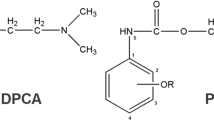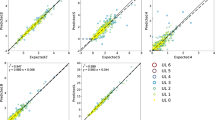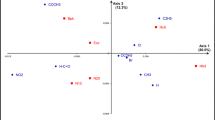Abstract
Quantitative structure–property relationship (QSPR) models are built for the set of 233 very different organic chemical compounds for the estimation of the solute polarity parameter p. QSPR models for the solute polarity parameter p are calculated with optimal descriptors based on a SMILES notation, and all models were developed using the Monte Carlo method where the end point is threaded as a random event. Models were prepared in accordance with the OECD principles and recommendations. Three random splits into the training, test, and validation sets were examined. The statistical quality of all build models was very good. The best calculated model had the following statistical parameters: for the training set r 2 = 0.9493, q 2 = 0.9479, s = 0.285, F = 2564; r 2 = 0.9608, q 2 = 0.9561, s = 0.249, F = 1102 for the test set; and r 2 = 0.9418 and q 2 = 0.9349 for the validation set. Structural indicators (alerts) defined as molecular fragments for the increase/decrease in the solute polarity parameter p were defined.

Similar content being viewed by others
References
Snyder LR, Kirkland JJ, Dolan JW (2009) Introduction to modern liquid chromatography, 3rd edn. Wiley, New York
Poole CF (2003) The essence of chromatography. Elsevier, Amsterdam
Rosés M, Bosch E (1993) Anal Chim Acta 274:147–162
Bosch E, Bou P, Rosés M (1994) Anal Chim Acta 299:219–229
Rosés M, Bolliet D, Poole CF (1998) J Chromatogr A 829:29–40
Torres-Lapasio JR, Garcia-Alvarez-Coque MC, Rosés M, Bosch E (2002) J Chromatogr A 955:19–34
Torres-Lapasio JR, Garcia-Alvarez-Coque MC, Rosés M, Bosch E, Zissimos AM, Abraham MH (2004) Anal Chim Acta 515:209–227
Katritzky AR, Kuanar M, Slavov S, Hall CD, Karelson M, Kahn I, Dobchev DA (2010) Chem Rev 110:5714–5789
Katritzky AR, Lobanov VS, Karelson M (1995) Chem Soc Rev 24:279–287
Afantitis A, Melagraki G, Sarimveis H, Koutentis PA, Markopoulos J, Igglessi-Markopoulou O (2008) QSAR Comb Sci 27:432–436
Mercader AG, Duchowicz PR, Fernández FM, Castro EA (2010) J Chem Inf Model 50:1542–1548
Héberger KJ (2007) Chromatogr A 1158:273–305
Kaliszan R (2007) Chem Rev 107:3212–3246
Bonchev DJ (2000) Chem Inf Comp Sci 40:934–941
Estrada E, González HJ (2003) Chem Inf Comp Sci 43:75–84
Ivanciuc O (2013) Curr Comput Aid Drug 9:153–163
Toropov AA, Toropova AP, Benfenati E, Gini G (2013) Curr Comput Aid Drug 9:226–232
Daylight Chemical Information Systems, Inc (2008) http://www.daylight.com (accessed 11.02.14)
Toropov AA, Toropova AP, Benfenati E (2010) Eur J Med Chem 45:3581–3587
Toropov AA, Toropova AP, Rasulev BF, Benfenati E, Gini G, Leszczynska D, Leszczynski J (2012) J Comput Chem 33:1902–1906
Toropov AA, Toropova AP, Benfenati E, Gini G, Leszczynska D, Leszczynski J (2013) Chemosphere 90:877–880
Toropova AP, Toropov AA, Benfenati E, Gini G, Leszczynska D, Leszczynski J (2013) J Math Chem 51:1684–1693
Bosque R, Sales J, Bosch E, Rosés M, García-Alvarez-Coque MC, Torres-Lapasió JR (2003) J Chem Inf Comp Sci 43:1240–1247
Weininger D (1988) J Chem Inf Comp Sci 28:31–36
Weininger D, Weininger A, Weininger JL (1989) J Chem Inf Comp Sci 29:97–101
Weininger D (1990) J Chem Inf Comp Sci 30:237–243
Toropova AP, Toropov AA, Benfenati E, Gini G, Leszczynska D, Leszczynski J (2011) J Comput Chem 32:2727–2733
Veselinović AM, Milosavljević JB, Toropov AA, Nikolić GM (2013) Eur J Pharm Sci 48:532–541
Toropov AA, Toropova AP, Puzyn T, Benfenati E, Gini G, Leszczynska D, Leszczynski J (2013) Chemosphere 92:31–37
Roy K (2007) Expert Opin Drug Dis 2:1567–1577
Roy PP, Leonard JT, Roy K (2008) Chemom Intell Lab Syst 90:31–42
Golbraikh A, Tropsha A (2002) J Mol Graph Model 20:269–276
Roy PP, Roy K (2009) Chem Biol Drug Des 73:442–455
Ojha PK, Mitra I, Das RN, Roy K (2011) Chemometr Intell Lab 107:194–205
Ojha PK, Roy K (2011) Chemometr Intell Lab 109:146–161
Roy K, Mitra I, Kar S, Ojha PK, Das RN, Kabir H (2012) J Chem Inf Model 52:396–408
Tropsha A (2010) Mol Inf 29:476–488
Toropov AA, Toropova AP, Benfenati E, Fanelli R (2013) Struct Chem 24:1369–1381
Organisation for Economic Co-operation and Development (2007) Guidance document on the validation of (quantitative) structure-activity relationship [(Q)SAR] models. OECD Series on Testing and Assessment 69. OECD Document ENV/JM/MONO (2007) 2
Acknowledgments
This work has been supported by the Ministry of Education, Science and Technological Development, the Republic of Serbia, under Project Number 31060. APT and AAT acknowledge support from the EC project NANOPUZZLES (Project Reference: 309837), EU FP7 project PreNanoTox (contract 309666), and EC project CALEIDOS (the project number LIFE11-INV/IT 00295).
Author information
Authors and Affiliations
Corresponding author
Electronic supplementary material
Below is the link to the electronic supplementary material.
Rights and permissions
About this article
Cite this article
Veselinović, A.M., Veselinović, J.B., Nikolić, G.M. et al. QSPR models for estimating retention in HPLC with the p solute polarity parameter based on the Monte Carlo method. Struct Chem 27, 821–828 (2016). https://doi.org/10.1007/s11224-015-0636-2
Received:
Accepted:
Published:
Issue Date:
DOI: https://doi.org/10.1007/s11224-015-0636-2




